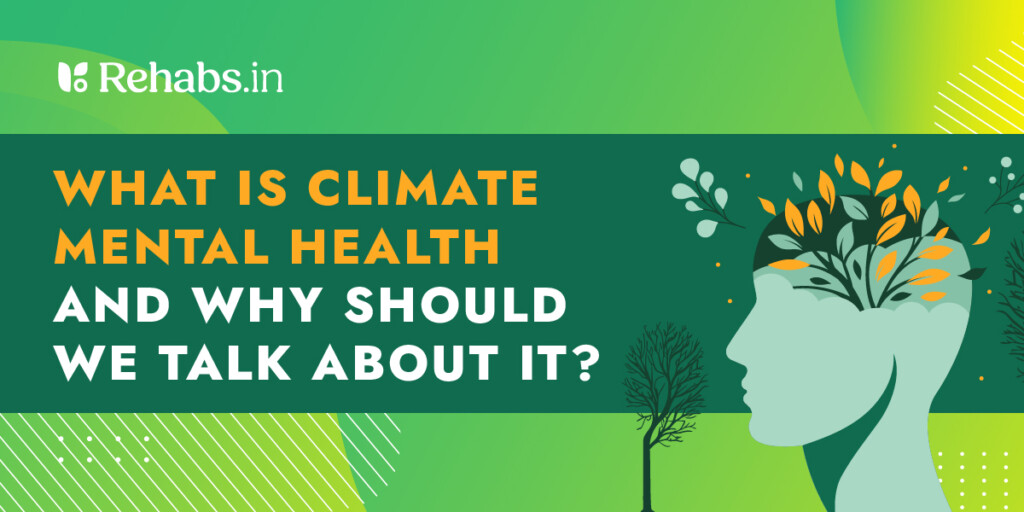What is climate mental health and why should we talk about it?

Have you ever felt a wave of sadness after seeing news of a wildfire, flood, or vanishing forest? Or maybe a quiet sense of dread when thinking about the future of our planet? You’re not alone. More and more people around the world are experiencing emotional distress linked to climate change even if they haven’t been directly affected by a disaster.
This growing concern has a name: climate mental health. It refers to the psychological and emotional impact of climate change on individuals and communities. From anxiety and grief to helplessness and burnout, the mental toll of a changing planet is real, and it’s rising.
While much of the conversation around climate change focuses on the environment, it’s just as important to talk about what it’s doing to our minds and hearts. This blog will explore what climate mental health really means, who it affects, and why addressing it is crucial for a more hopeful, sustainable future.
What Is Climate Mental Health?
Climate mental health refers to the emotional, psychological, and social effects of climate change on individuals and communities. It goes beyond physical safety or property damage it’s about how people feel in response to environmental changes, and how those feelings impact their well-being.
As climate change becomes more visible through rising temperatures, extreme weather, and ecosystem loss so do its mental health consequences. People are experiencing stress, anxiety, grief, and even trauma as they witness the damage or worry about what’s to come.
Some common emotional responses include:
- Eco-anxiety: Chronic worry about the future of the planet.
- Climate grief: Mourning the loss of nature, biodiversity, or a way of life.
- Solastalgia: A sense of homesickness while still being at home, caused by environmental change.
- Climate trauma: Psychological distress following a climate-related disaster.
These responses are not signs of weakness they’re valid reactions to a very real crisis. And just like physical health, mental health deserves attention in climate conversations.
How Climate Change Affects Mental Health
Climate change affects mental health in both direct and indirect ways. While some people face trauma after disasters, others carry a quiet, ongoing weight of uncertainty and fear. Let’s break it down:
Direct Impacts
- Natural Disasters: Events like floods, wildfires, hurricanes, and heatwaves can lead to post-traumatic stress disorder (PTSD), depression, and anxiety. Survivors may experience sleep disturbances, survivor’s guilt, or long-term emotional distress.
- Displacement and Loss: Losing homes, livelihoods, or loved ones due to climate-related events can deeply affect a person’s mental health and sense of stability.
Indirect Impacts
- Chronic Stress and Anxiety: Even those not directly affected by climate disasters may feel persistent worry about the planet. This is common among young people, environmentalists, and those in vulnerable areas.
- Existential Distress: Many people report feeling overwhelmed, hopeless, or disconnected when thinking about the future of humanity or the irreversible damage to the Earth.
- Lifestyle Disruption: Farmers, fishermen, and other climate-affected workers may struggle with identity loss, financial stress, and emotional fatigue.
The mental health effects of climate change are not always visible but they are very real. Recognizing them is the first step toward healing and action.
Who Is Most Affected by Climate Mental Health Issues?
While climate change touches everyone in some way, certain groups are more emotionally and psychologically impacted than others. These groups often face added layers of vulnerability due to age, geography, occupation, or social position.
1. Young People
Children, teenagers, and young adults are among the most affected. Many feel anxious, angry, or helpless about inheriting a world in crisis. Studies have shown that climate anxiety is especially high among youth who feel governments are not doing enough to protect their future.
2. Marginalized Communities
Communities already facing poverty, discrimination, or lack of access to healthcare are often hit hardest by climate change and have the least resources to cope. This includes low-income families, indigenous populations, and people in climate-vulnerable regions.
3. Climate Scientists and Activists
People working in environmental fields or engaged in climate activism often experience emotional burnout, hopelessness, and what’s called vicarious trauma emotional distress from constant exposure to climate-related suffering.
4. People with Lived Experience of Climate Disasters
Survivors of floods, droughts, wildfires, and other disasters may carry long-term trauma, especially if they face repeated events or lack stable recovery support.
Climate Mental Health in the Indian Context
India is one of the countries most vulnerable to climate change and the emotional toll is becoming harder to ignore. From deadly heatwaves in Delhi to devastating floods in Kerala and cyclones along the coasts, millions are already experiencing the psychological effects of a shifting climate.
1. Rural and Farming Communities
Many Indian farmers face extreme weather patterns, crop failures, and water shortages, all of which contribute to stress, anxiety, and financial strain. Research has linked climate-related pressures to mental health challenges and even farmer suicides in some regions.
2. Urban Populations
In cities, climate anxiety is rising especially among youth who see environmental decline and feel powerless to act. Air pollution, water scarcity, and intense heat affect not just physical health but emotional well-being too.
3. Displacement and Migration
Floods, droughts, and changing weather are forcing people to leave their homes in search of safety and work. This kind of climate-induced migration often leads to identity loss, stress, and disruption of community bonds.
4. Mental Health Infrastructure Gaps
India’s mental health system is still growing, and access to care remains limited especially in rural areas. This makes it even more critical to acknowledge and address climate-related emotional struggles early on.
Why Is It Important to Talk About Climate Mental Health?
We often talk about rising temperatures, melting glaciers, or extreme weather but not enough about the emotional weight all of this carries. Addressing climate mental health is not just about feelings; it’s about survival, resilience, and creating a healthier response to a global crisis.
1. It Validates Real Emotions
People experiencing eco-anxiety or climate grief often feel isolated or “too sensitive.” Talking openly about these emotions helps normalize them. It shows that distress about the planet is not only valid it’s a sign of awareness and care.
2. It Reduces Stigma
Mental health is still stigmatized in many parts of the world, including India. By linking it to a global issue like climate change, we make it easier to have compassionate conversations about emotional well-being.
3. It Encourages Coping and Action
When people feel emotionally overwhelmed, they may shut down or disconnect. Talking about climate mental health helps individuals move from helplessness to hope. It also empowers people to take small, meaningful steps whether that’s joining a community group, making sustainable choices, or seeking support.
4. It Influences Policy and Preparedness
Mental health support is often missing from climate disaster planning. By raising awareness, we push for more holistic policies that include emotional care in disaster response, education, and climate adaptation strategies.
What Can Help? Coping Strategies and Collective Action
Individual Coping Strategies
- Acknowledge Your Emotions: Allow yourself to feel anxiety, sadness, or grief without judgment. These are natural responses to environmental loss and uncertainty.
- Limit Doomscrolling: Stay informed, but take breaks from constant negative news. Curate your media diet to include stories of climate solutions and community action.
- Connect with Nature: Spending time in green spaces, even small ones, has been shown to reduce stress and restore emotional balance.
- Set Realistic Goals: Focus on actions within your control like reducing waste, conserving energy, or supporting local sustainability efforts.
- Talk About It: Share your thoughts with friends, therapists, or support groups. Expressing emotions helps prevent internalizing them.
Collective and Systemic Support
- Community-Based Initiatives: Join or support local environmental or mental health groups that offer peer support and shared action.
- Mental Health Education: Schools, colleges, and workplaces can include conversations around climate emotions, especially for young people.
- Climate-Informed Therapy: Therapists are now being trained to address eco-anxiety and climate grief. Mental health services need to adapt to these new realities.
- Policy and Infrastructure: Governments must integrate mental health into climate adaptation plans especially in disaster-prone regions and vulnerable communities.
Conclusion
As the climate crisis unfolds, it’s clear that the impact goes far beyond rising sea levels and heatwaves it touches our minds, emotions, and relationships. Climate mental health is a growing, but often invisible, part of this story.
By acknowledging and talking about our emotional responses like eco-anxiety, grief, or helplessness we take an important step toward healing. These feelings don’t make us weak; they make us human. And when supported with the right tools, communities, and policies, they can even become sources of motivation and connection.
Sources:
American Psychological Association. (2017). Mental health and our changing climate: Impacts, implications, and guidance. https://www.apa.org/news/press/releases/2017/03/mental-health-climate.pdf
Clayton, S., Manning, C., Krygsman, K., & Speiser, M. (2017). Mental health and our changing climate: Impacts, implications, and guidance. American Psychological Association and ecoAmerica.
Cunsolo, A., & Ellis, N. R. (2018). Ecological grief as a mental health response to climate change-related loss. Nature Climate Change, 8(4), 275–281. https://doi.org/10.1038/s41558-018-0092-2
Hickman, C., Marks, E., Pihkala, P., Clayton, S., Lewandowski, R. E., Mayall, E. E., Wray, B., Mellor, C., & van Susteren, L. (2021). Climate anxiety in children and young people and their beliefs about government responses to climate change: A global survey. The Lancet Planetary Health, 5(12), e863–e873. https://doi.org/10.1016/S2542-5196(21)00278-3
Palinkas, L. A., & Wong, M. (2020). Global climate change and mental health. Current Opinion in Psychology, 32, 12–16. https://doi.org/10.1016/j.copsyc.2019.06.023
Reser, J. P., & Swim, J. K. (2011). Adapting to and coping with the threat and impacts of climate change. American Psychologist, 66(4), 277–289. https://doi.org/10.1037/a0023412
van Susteren, L. (2020). The emotional toll of climate change. In T. E. Lovejoy & L. Hannah (Eds.), Climate change and biodiversity (pp. 259–264). Yale University Press.
World Health Organization. (2022). Climate change and mental health: Policy brief. https://www.who.int/publications/i/item/9789240053174















